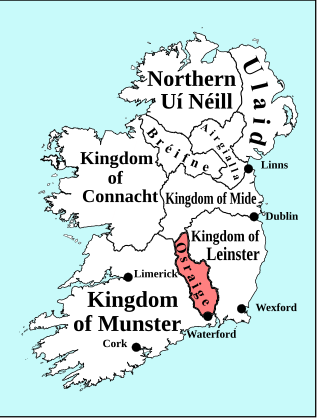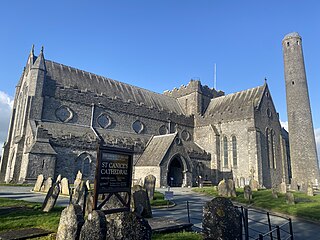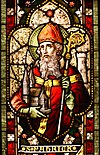
Ninian is a Christian saint, first mentioned in the 8th century as being an early missionary among the Pictish peoples of what is now Scotland. For this reason he is known as the Apostle to the Southern Picts, and there are numerous dedications to him in those parts of Scotland with a Pictish heritage, throughout the Scottish Lowlands, and in parts of Northern England with a Northumbrian heritage. He is also known as Ringan in Scotland, and as Trynnian in Northern England.

Saint Molaiseof Leighlin, also Laisrén or Laserian, was an early Irish saint and abbot of Lethglenn or Leithglenn, now Old Leighlin in County Carlow, who is supposed to have lived in the 6th and 7th centuries. In Scotland, he is known as "Molaise" while in Ireland he is revered as "Laserian".
Óengus mac Óengobann, better known as Saint Óengus of Tallaght or Óengus the Culdee, was an Irish bishop, reformer and writer, who flourished in the first quarter of the 9th century and is held to be the author of the Félire Óengusso and possibly the Martyrology of Tallaght.

The kings of Osraige reigned over the medieval Irish kingdom of Osraige from the first or second century AD until the late twelfth century. Osraige was a semi-provincial kingdom in south-east Ireland which disappeared following the Norman Invasion of Ireland. A number of important royal Ossorian genealogies are preserved, particularly MS Rawlinson B502, which traces the medieval Mac Giolla Phádraig dynasty back through Óengus Osrithe, who supposedly flourished in the first or second century. and one in the Book of Leinster. Recent analysis of ninth and tenth century regnal succession in Osraige has suggested that in peaceful times, kingship passed primarily from eldest to youngest brother, before crossing generations and passing to sons and nephews.

Osraige or Osraighe, Osraí, anglicized as Ossory, was a medieval Irish kingdom comprising what is now County Kilkenny and western County Laois, corresponding to the Diocese of Ossory. The home of the Osraige people, it existed from around the first century until the Norman invasion of Ireland in the 12th century. It was ruled by the Dál Birn dynasty, whose medieval descendants assumed the surname Mac Giolla Phádraig.

Ciarán of Saigir, also known as Ciarán mac Luaigne or Saint Kieran, was one of the Twelve Apostles of Ireland and is considered the first saint to have been born in Ireland, although the legend that he preceded Saint Patrick is questionable. Ciarán was bishop of Saighir (Seir-Kieran) and remains the patron saint of its successor, the diocese of Ossory.
Broccán Clóen was an Irish cleric who lived in the sixth or seventh century.
Killeshin is a village in County Laois, Ireland on the R430 regional road. Killeshin is a small rural community situated five kilometres west of Carlow town and overlooks the picturesque Barrow Valley. The church at the foot of Slievemargy, the hill above Killeshin, is the site of an early Christian monastery. The village is in a townland and civil parish of the same name.

The Diocese of Ossory is a Latin Church diocese of the Catholic Church in eastern Ireland. It is one of three suffragan dioceses in the ecclesiastical province of the Metropolitan Archbishop of Dublin. Currently, it is led by Niall Coll who was appointed on 28 October 2022 and will be ordained bishop on 22 January 2023.
Eithne and her sister Sodelb are two relatively obscure Irish saints from Leinster who are supposed to have flourished in the 5th century. They are commemorated together in the Irish martyrologies on 29 March, though 2 and 15 January were also marked out as feast-days. The 17th-century scholar John Colgan believed that a Life written for them had been witnessed in c. 1490 by Cathal Óg Mac Maghnusa, whom he regarded as the author of additions to the Félire Óengusso. Although nothing of the kind has come to light, they do make cameo appearances in the Lives of two better-known 6/7th-century saints, Áedan and Moling, both bishops of Ferns.

St. Modomnóc of Ossory was an Irish saint and missionary in Osraige who was a disciple of St. David of Wales and a member of the Uí Néill royal family. His feast day is February 13.

The Bishop of Ossory is an episcopal title which takes its name after the ancient of Kingdom of Ossory in the Province of Leinster, Ireland. In the Roman Catholic Church it remains a separate title, but in the Church of Ireland it has been united with other bishoprics.

St Canice's Cathedral, also known as Kilkenny Cathedral, is a cathedral of the Church of Ireland in Kilkenny city, Ireland. It is in the ecclesiastical province of Dublin. Previously the cathedral of the Diocese of Ossory, it is now one of six cathedrals in the United Dioceses of Cashel and Ossory.
St. Goban, St. Gobban, or St. Gobhan is the name of various Saints of early Christian Ireland. However the ecclesiastic integrity and merit of the Saint(s) is often debased by confusing, composite attempted biographies. However, by applying objectivity (philosophy) to the analysis of references in pertinent hagiography and eminent biographies we can reach a constructive conclusion; that the number of references to a St. Gobban far outweighs those of a St. Goban. and that the references to St.Gobban link this saint to St Laserian's Cathedral, Old Leighlin plus Killamery:Cell Lamraidhe and identify this saint as Gobban Find mac Lugdach alternatively anglicized as St. Gobhan.
Nem Moccu Birn was Abbot of Aran. His feast day is 14 June.

Saint Gobhan has long been linked with the parish of Seagoe – recorded for instance as Teach dho-Ghobha – in County Armagh, Ireland.

Freynestown is a townland in the civil parish of Tiscoffin in the barony of Gowran, County Kilkenny, Ireland. Freynestown was anciently located in the Kingdom of Ossory and derives its name from the Cambro-Norman family of "de la Freyne.".

Tiscoffin is a civil parish, in County Kilkenny, Ireland.

Mobhí Clárainech was an Irish early monastic saint, counted as one of the Twelve Apostles of Ireland. He was the abbot of a monastery in Glasnevin, where he was a teacher of Columba, Canice, Comgall, and Ciarán.

Mac Giolla Phádraig is a native Irish dynastic surname which translates into English as "Son of the Devotee of (St.) Patrick". In the medieval period, the Mac Giolla Phádraigs were hereditary kings of Osraige; today, the anglicised version of the name is commonly "Fitzpatrick".

















